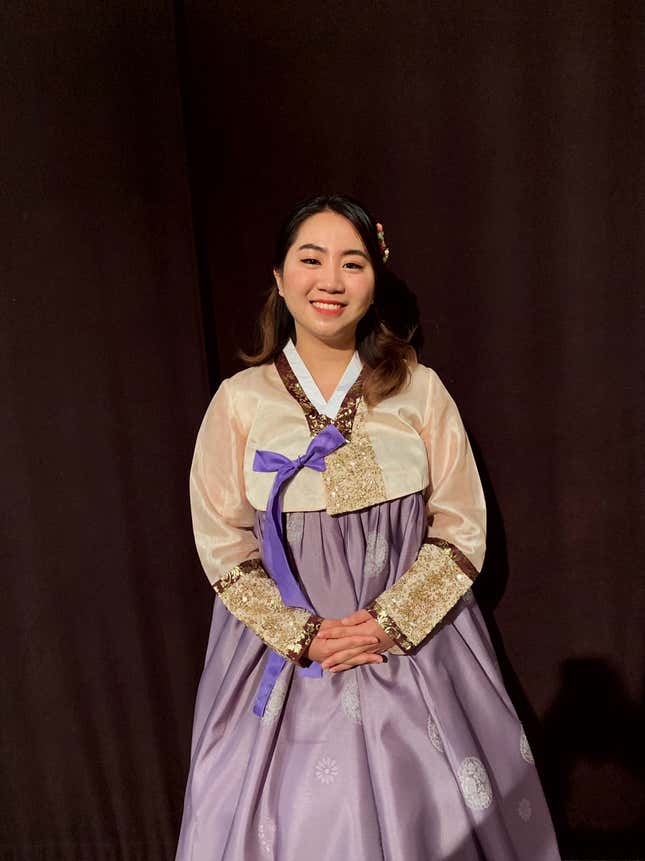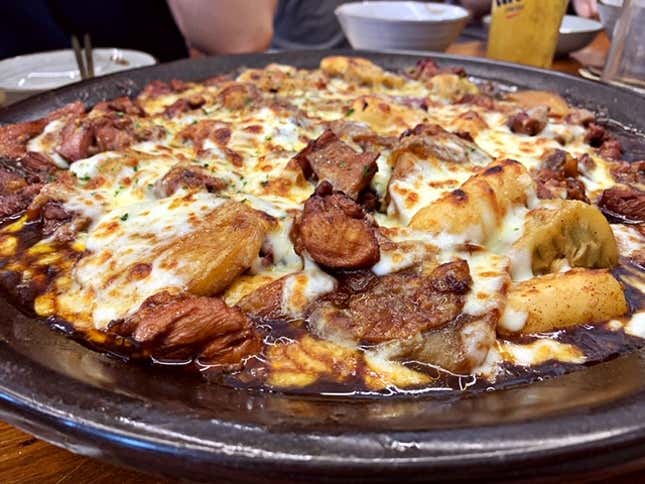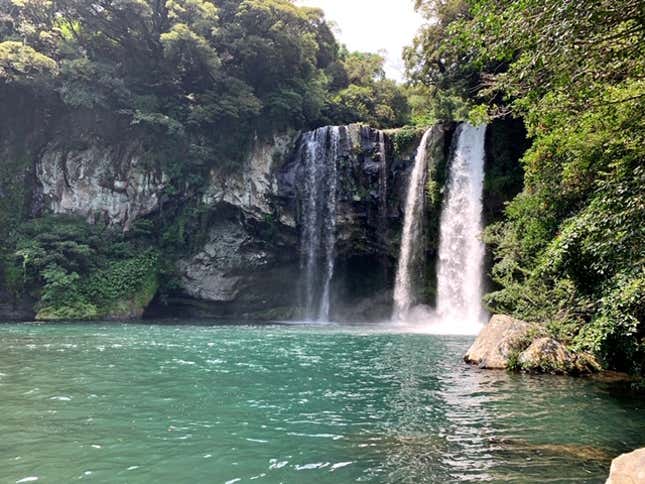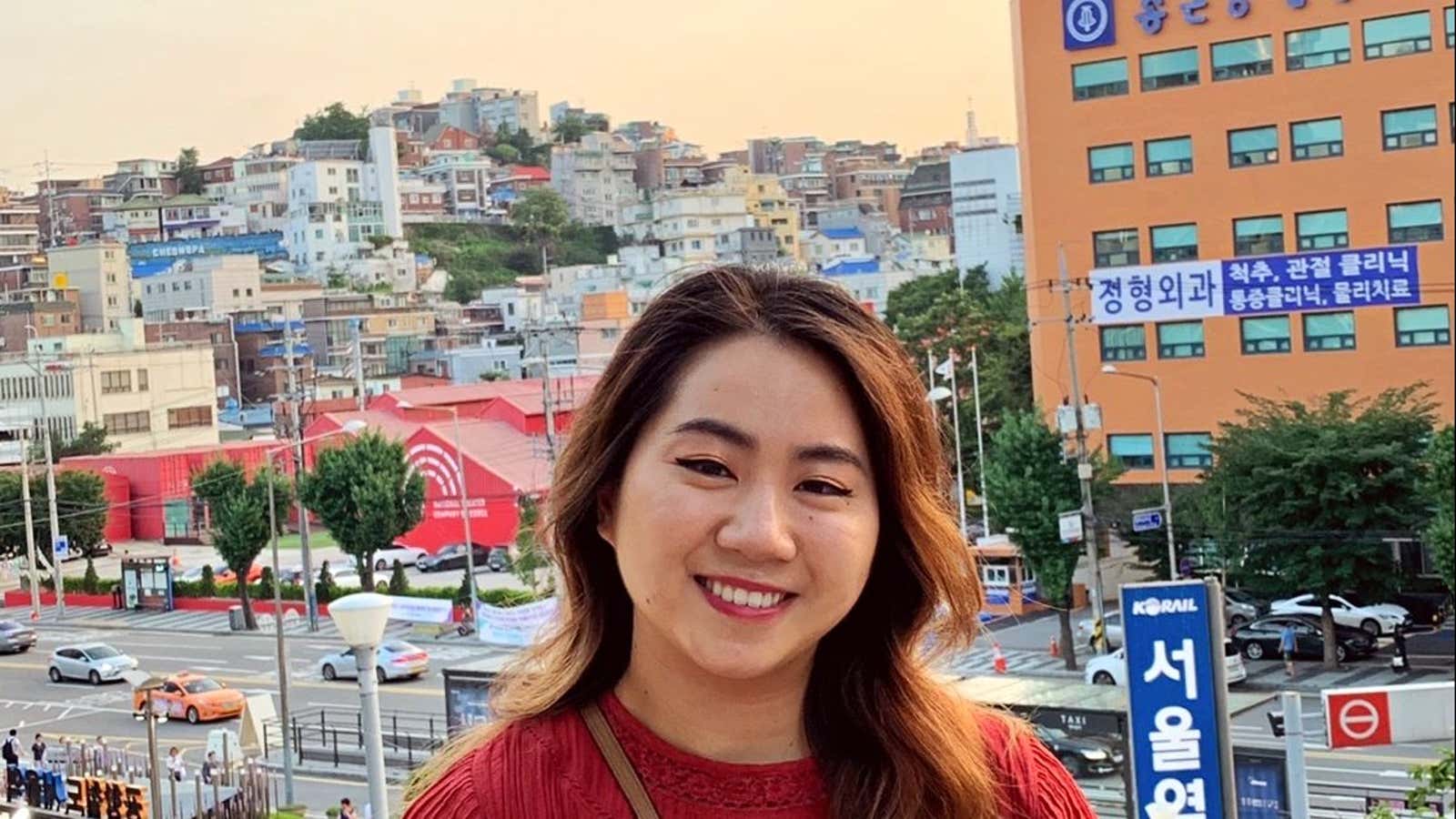I have two places I call home. One is the place where I’ve lived almost my whole life. It’s where I spoke my first words and made my first friends; it’s where I live and work today. My other home is the country where I was born—a country I had no memories of, until last year.
I am just one of more than 200,000 Korean adoptees exported from South Korea since the 1950s. When I was five months old, I was flown out of South Korea and raised in a New York suburb by a white family in a largely white community.
Then, last year, I embarked on a two-week trip to South Korea primarily to attend the International Korean Adoptee Association (IKAA) gathering, held every three years. During this time, more than 550 Korean adoptees from all over the world convened at the Lotte Hotel in Seoul to attend workshops and social events.
For many Korean adoptees (or KADs, as we often refer to ourselves), myself included, it was our first time returning to Korea since we were adopted as infants or children. I was careful not to make the assumption that Korea would immediately feel like home—after all, I had no active memories of the country, and I knew having unrealistic expectations would set myself up for disappointment. I wondered if it was indeed possible to become attached to a place that, for me, held so much history, yet so little familiarity.
What I found, in the end, was the bittersweet grief that comes with being reunited with your birth country. I discovered that it was possible to swell with immeasurable pride at the beautiful, resilient country I was born into, and in the next moment be filled with agony that I was denied the chance to be raised among my culture, my language.
The luxury of blending in
Alongside an older Korean-adoptee brother, I had a mostly happy childhood. My parents provided opportunities for us to connect to our heritage, whether by taking us to Korean restaurants or enrolling us in Korean culture camp. But inevitably, my curiosity about Korean culture expanded beyond these occasional experiences. In my teens, I started watching Korean dramas and listening to K-pop, hooked by the head-bopping tunes and synchronized choreography of the group Girls’ Generation. When I was 15, kept awake one night by my frustration with not understanding Korean, I impulsively decided to teach myself Hangul, the Korean alphabet—and so began what has now been a decade-long journey of reclaiming my birth language.
In Korea, my adjustment to my birth country was aided enormously by my ability to read and write Korean and speak it conversationally. It was enough to engage in small talk and transactional dialogue, enough to blend in if I really wanted to—and I did want to. For transracial adoptees, blending in is a luxury we often aren’t afforded: We carry a unique burden (or blessing, depending on how full your glass is) in which we completely belong neither to the cultures or families we were raised in, nor to the country we were born in.
Being proud of our circumstances and who we’ve become is empowering, and helps us take ownership of something we had no say in. Look deeper among adoptees, though, and you’ll often find an anxiety that betrays that pride. Telling a non-adopted Korean that you’re an adoptee often goes one of two ways—you will either be relegated to some shameful, pitied corner of not-Korean-enough, or you will be accepted with open arms. It’s a hell of a coin toss. It’s the reason why the adoptee community is so tightly knit; our otherness is the glue that binds us. Navigating the gray areas of one’s heritage is better together, I always say.

That was one reason I’d wanted to go to Korea as part of a group. Rather than being paced out throughout the week, most of the IKAA workshops were packed back-to-back into one day, making for a hectic and emotional few hours. One of my friends led a self-love workshop, during which we wrote letters of introspection and encouragement to our future selves.
As I sat there with KADs of various ages and nationalities, silent except for the sound of pens scratching on paper, it dawned on me how powerful this was—how powerful we were to have returned to our birth country together, on our own terms, after all these years.
While the IKAA gathering was the primary reason for my trip, I ultimately found more solace exploring Seoul outside of the gathering, on my own time and itinerary. I don’t drink, so the alcohol-fueled socializing that brought everyone else together didn’t appeal to me. I found myself instead ambling along the Cheonggyecheon River at night, or wandering through the characteristically winding backstreets of Korean neighborhoods. I squinted at the windows of strangers, trying to see myself in those tiny apartments stacked like a child’s haphazard building blocks. The people inside cooked dinner or watched TV, the same things that I did, but I also couldn’t forget that there were a million cultural differences folded into those simple, common acts.
The fact that I could stroll anonymously along the streets and be just another face in the crowd, instead of a specifically Asian face in the crowd, made me giddy with freedom. But there were times when my ever-present imposter syndrome was dialed up to the max. You look like them, but you’re not really one of them, a voice in my head sneered. Who are you trying to fool?
The more time I spent in Korea, the quieter that voice got. In fact, sometimes I felt like I was living in a parallel universe of my life had I not been adopted. On the pristine, efficient subway, I imagined a life where I took this train daily, on my way to work or school. I saw parents with children happily shouting “Umma” and “Appa” (“Mom” and “Dad,” respectively). At a jjimjilbang, a Korean sauna, I felt a dull ache in my chest watching a woman my age playfully banter with her mother and grandmother as they scrubbed each other and then lounged in the baths. These rituals were second-nature to them, but totally foreign to me. I fantasized about what growing up in a nuclear Korean family would have been like. Of course, even if I had not been adopted, such a family would most likely not have been my reality, as is the case for many KADs.
Homecoming days
Not all reminders of what I had missed were wistful. Everywhere I went, there were cosmetics advertisements generously plastered on buses and buildings, with popular Korean actors promising bigger eyes, brighter skin, and social acceptance. While I’m an enthusiastic consumer of Korean beauty, I’m also very aware of the darker side of Korea’s demanding beauty standards. Some things are better to have missed out on.
I shifted constantly between my needs for companionship and solitude. As an introvert, being accompanied by other KADs all the time didn’t allow me the mental space to thoroughly process my experience. I was too busy absorbing my friends’ feelings to really check in with myself, and I often felt the need to break away from the group and take solo walks. Other times, though, the unfamiliarity of my birth country became too much to bear, and I sought the company of my friends—people who would understand why I felt like bursting into tears surrounded by dumplings at a street market.
In fact, there were few moments when I wasn’t surrounded by food. In between sweating profusely from the daily 95% humidity, I was eating. While I am fortunate to never be deprived of excellent Korean food living in New York City, the availability—and comparative affordability—of the food in Korea pushed me into a feeding frenzy.
Some of my favorite Korean dishes are the communal ones, comfort food meant to be eaten and shared with the people you love: jjimdak, a braised dish of chicken and vegetables often smothered in melted mozzarella cheese; dakgalbi, spicy chicken tossed with cabbage, rice cakes, and sweet potato; and of course, Korean barbecue. I’ve eaten these dishes with family and friends in the US, and now shared them with friends old and new in Korea. Some of the best Korean street food can be found at the markets, and I was hypnotized by the mountains of spicy rice cakes and crispy mung-bean pancakes at the famous Gwangjang Market. Food is one of the biggest ways in which I stay connected to Korean culture, and I ate my fill.

Before I left Seoul, I set aside a day to visit Daejeon, the city where I was born. After a scenic hour through the countryside on the KTX bullet train, I stepped outside, took a deep breath, and looked around.
It was a sweltering day. Beyond the tall urban buildings, I could see emerald mountains looming in the distance. I felt a strange sense of homecoming, which only made me feel lonelier—I had no family, no friends there to welcome me back. Around me, people walked in pairs or groups, laughing and talking with each other. I’m back!, I wanted to shout at them. It took me 24 years, but I’m back! Has anyone missed me? They walked on.
I wandered aimlessly for about two hours before the heat and dehydration sent me back to Seoul. As lonely as I had felt, there was also a gratifying sense of closure that Daejeon was no longer just a scrabble of letters, but a real place. I now had context as to where I had spent the first five months of my life, and for that I was grateful.
The ascent
For the second half of my trip, I headed south to Jeju Island with a few other friends. I had long dreamed of visiting Jeju, and it was a welcome respite from the constant pace of Seoul. In Seogwipo, a serene coastal city on the southern end of the island, we stayed in a modest, homey hotel overlooking the ocean. The sun was setting; we couldn’t figure out how the air conditioner worked. I had never been happier.

Public transit on Jeju is limited, so we opted to get around by cab, a decision that thankfully ended up being less costly than the price quoted to us for a rental car. We did the tourist-y things: We trekked to the Cheonjeyeon waterfall, a glittering oasis of emerald and turquoise. I watched in amusement as waves of Koreans arrived, took their obligatory selfies, and promptly left, a move that a friend later affirmed to me as “totally Korean.” On the west side, we walked along the rocky coast, where Jeju’s wind turbines stood proudly against the lapping waves. We took our own obligatory photos at the lush green tea fields at Osulloc. But higher on my to-do list, in the most literal sense possible, was Hallasan.
Jeju Island is home to Hallasan, the tallest mountain in Korea. I had my heart set on climbing it. The others weren’t quite as enthusiastic, so I steeled myself for a solo climb. I’m sure I was driven by some poetic desire to scale my tallest mountain/reach my highest peak/overcome my biggest obstacle, but at the time, all I felt was a calm determination. When morning came, I hailed a cab to the foot of the mountain, took a deep breath, and strode into the forest.
Every few minutes, I was easily overtaken by seasoned ajummas who probably knew the path by heart. I would occasionally pass people who, noticing I was alone, would voice their concern, and there was a sense of camaraderie among the hikers—every so often, an encouraging “Sugohaseyo!” (“Keep it up!”) would ring out through the woods.
After a few hours, though, something shifted. What had seemed like a friendly challenge at the bottom of the mountain soon revealed itself to be a test of endurance unlike any other I had experienced. Every step seemed to sap every ounce of my energy, and I felt certain that I was not climbing to the top, but instead stuck on a hellish, never-ending ascent.
By some miracle, I eventually did make it to the summit, gasping and drenched in sweat. As the cool mountain air filled my lungs and clouds swirled around my head, I felt the immensity of what I had just done. Far below me, cars drove, people conversed, life went on—and at that moment, none of it mattered. The trivialities of everyday life seem quite small when you’re 6,398 feet up.
No sooner had I sat down to rest, it seemed, that a ranger at the top announced it was time to head back down. The descent was a race against the rapidly setting sun, to the dismay of my knees. When I deliriously reached the bottom at around 6:30 pm, I felt like I had stepped out of a portal. For the past nine hours, my physical and mental staminas had been at war with themselves, my fate dependent on taking one more step forward—and just like that, it was over. I won’t be climbing Hallasan again anytime soon, but to know that I can, and did, is enough.
Too soon, the day came to leave Korea. As the plane lifted into the sky, I felt a deeply buried wound open inside my chest, and the tears I had been holding in for most of the trip poured out. I thought of the first time I had left Korea, as a baby, unaware of what (and who) I was leaving behind or where I was going, unable to say goodbye. Twenty-four years’ worth of sorrow hit me head-on, and I found myself feeling homesick for a place I had never considered home until now.
In my dreams, I am back in Korea, or trying to go back. The setting changes, but there is always the feeling of chasing something lost and the relief of finding it. I’m not alone in this yearning, either; I know several KADs who are either preparing to permanently return to Korea, or have already done so.
I, too, have thought about making the big move. But however much I might feel at home in Korea, I can’t deny that my home is here, too: Home is my apartment, my parents’ house, New York, the US. There’s immense comfort in knowing that there’s a part of me in both countries. But wherever I go, I’ll be leaving something behind.
